John McLaren boasts over 25 years of experience in post-production, having contributed to various renowned studios like DNEG, Cinesite, MPC, and Outpost VFX. His impressive portfolio includes projects such as Watchmen, Foundation, Queen Charlotte: A Bridgerton Story, and The Wheel of Time.
What is your background?
I originally studied illustration at art college, and then specialised in photography at university. From there I went into advertising and was a Flame Op for many years at various facilities in London, then I jumped onto Shake before moving onto Nuke then through the ranks of compositing before getting the opportunity to be a VFX Supervisor at Outpost.
How did you get involved on this movie?
Outpost VFX had been involved in a sequence for the second season of Bridgerton, meaning there was already an established relationship with Shondaland and the Exec Producer / Director Tom Verica. This led to me to supervising on the Bridgerton spinoff Queen Charlotte, which then meant we were handed the reins for the VFX on Bridgerton S3.
What was your feeling to be part of this iconic universe?
We had to work from the already established look of S1 and S2, especially on the iconic Bridgerton and Featherington houses, so there was a feeling of responsibility in preserving this look and respecting what is a huge fanbase, but also a responsibility to improve on what had been done previously.
How was the collaboration with the showrunner, directors and the Production VFX Supervisor?
My role as VFX Supervisor was both production and vendor side. This meant that I was involved in the project from a very early stage and was able to discuss a lot of the methodology for VFX with the Exec Producer / Director, Tom Verica. This early involvement wasn’t only with Tom, but also showrunner, Jess Brownell, as well as Production Designers, DoP’s and Directors. Across the eight episodes in season three there were four different Directors, each Director owning two episodes, it also meant each Director had a different DoP, so collaboration was crucial right from the initial stages of script read through on each block.
How did you organize the work with your VFX Producer?
I had worked with the VFX producer Matthew Lynn on Queen Charlotte, so the relationship had already been established. Matthew was based in LA so many of our calls would take place end of day UK time. We already knew the look of a lot of our locations, so are main goal was to build on this look and finesse further what had already been done. Much of our time was spent reading through scripts and breaking down what could be achieved practically and what would require VFX. The VFX in Bridgerton are required to be historically correct and invisible, so a lot of references had to be used to make sure the VFX were period appropriate. With Matt and his team being based in LA and all the shooting happening in the UK, it meant we had to have regular calls to share info following tech recces and shoot days.
Can you describe the initial process of conceptualizing and designing the 19th-century London environments for Bridgerton Season 3?
There was already an established look from S1 and S2, so the look of the iconic locations – Bridgerton House, Featherington House, The Modiste and Grosvenor Square – had already been nailed down. Dotted in amongst these locations there are also a number of new one-off locations like the harbour scene created for Colin’s return in episode one, the church scene in episode six, the ballroom and glass ceiling environment for the butterfly ball in episode eight. To create these new environments we worked closely with the art department, specifically Alison Gartshore and Antony Cartlidge. They provided us with initial concepts which we used as blueprints for these environments.
There was a lot of research done for the harbour scene in episode one, especially into the construction of large passenger boats of the early 1800s as well as the look of London docks of this era – a lot of reference came from prints, paintings and historical docs of the time. All the way through this process we’d continue to collaborate with the art department to determine what would be practical and where VFX would take over.

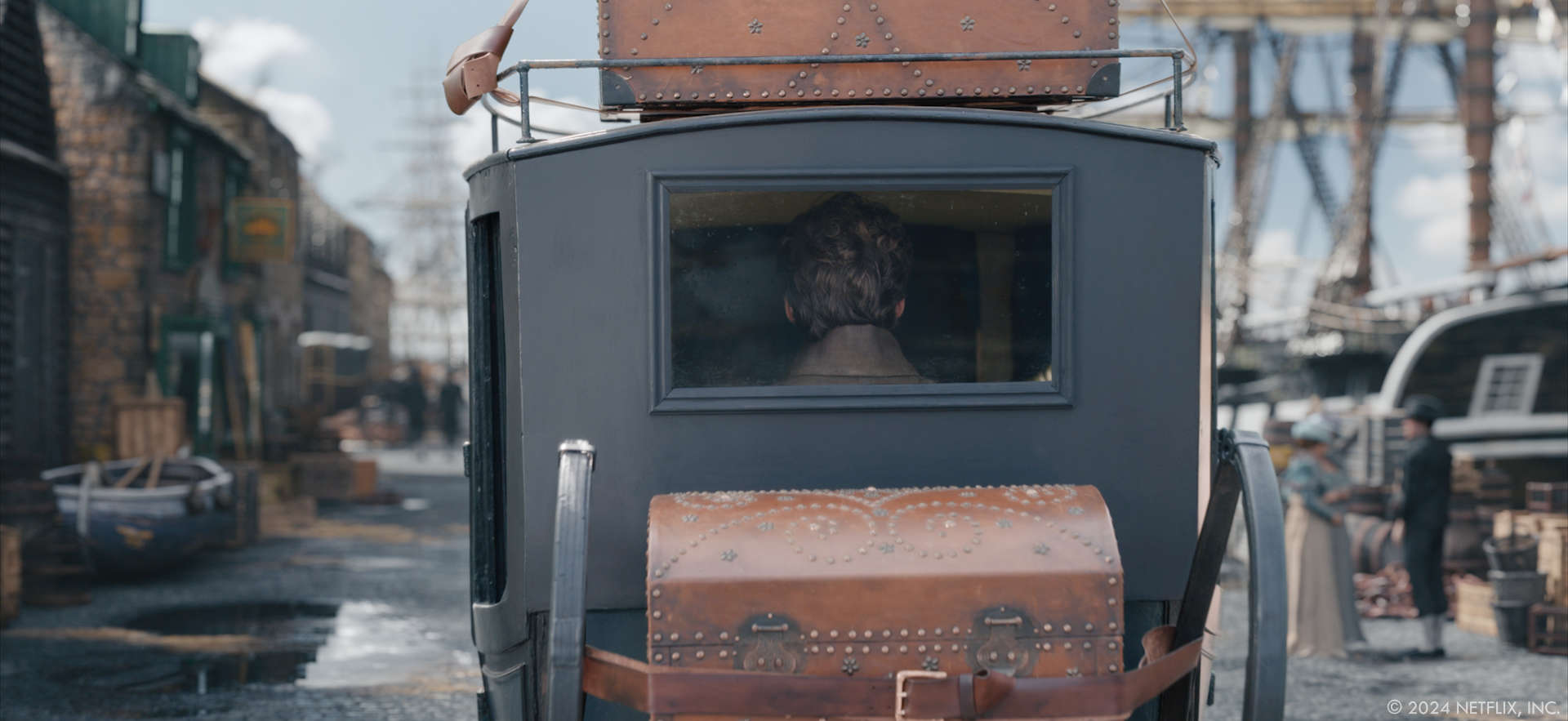
What were the biggest challenges in recreating authentic 19th-century London settings using visual effects?
It was paramount that the assets we created were period accurate, so a lot of time was spent researching the architecture of the time, as well as photographing and collecting textures from appropriate buildings in and around London. On the shooting locations where we were extending environments, the challenges were in ensuring we removed all modernities in the shots without leaving the scenes looking sterile and lifeless. Bridgerton’s visual style is both bold and vibrant – this in itself presents challenges where you’re trying to find the visual balance between weathering assets for authenticity and realism but also staying within the Bridgerton look.
How did you ensure historical accuracy while also making the environments visually appealing for a modern audience?
We were also faced with a lot of challenges with the ever changing weather conditions as shooting extended into autumn and the landscape lost the vibrancy associated with the traditional look of Bridgerton. This meant a lot of restoring leaves on trees, bringing back green grass and cold breath removal.
Can you explain the role of practical sets versus CGI in depicting 19th-century London in this season?
Bridgerton practical sets were spread across the UK; Bath, Greenwich, Salisbury and Lincolnshire to name a few. The locations were truly stunning, grand stately homes, estates and parks.
Although all grand and lavish, they also required meticulous VFX work to replace architectural features that were not appropriate to the period. Practical sets normally required green screens for extensions or CG replacements. This was more extensive on the scenes around the Bridgerton House (Rangers House, Greenwich) where we had to use both static and mobile large green screens to give the Director the flexibility to shoot all angles around the house, giving views of the surrounding neighbourhood – Grosvenor Square and Featherington – all of which needed to be modelled in CG.
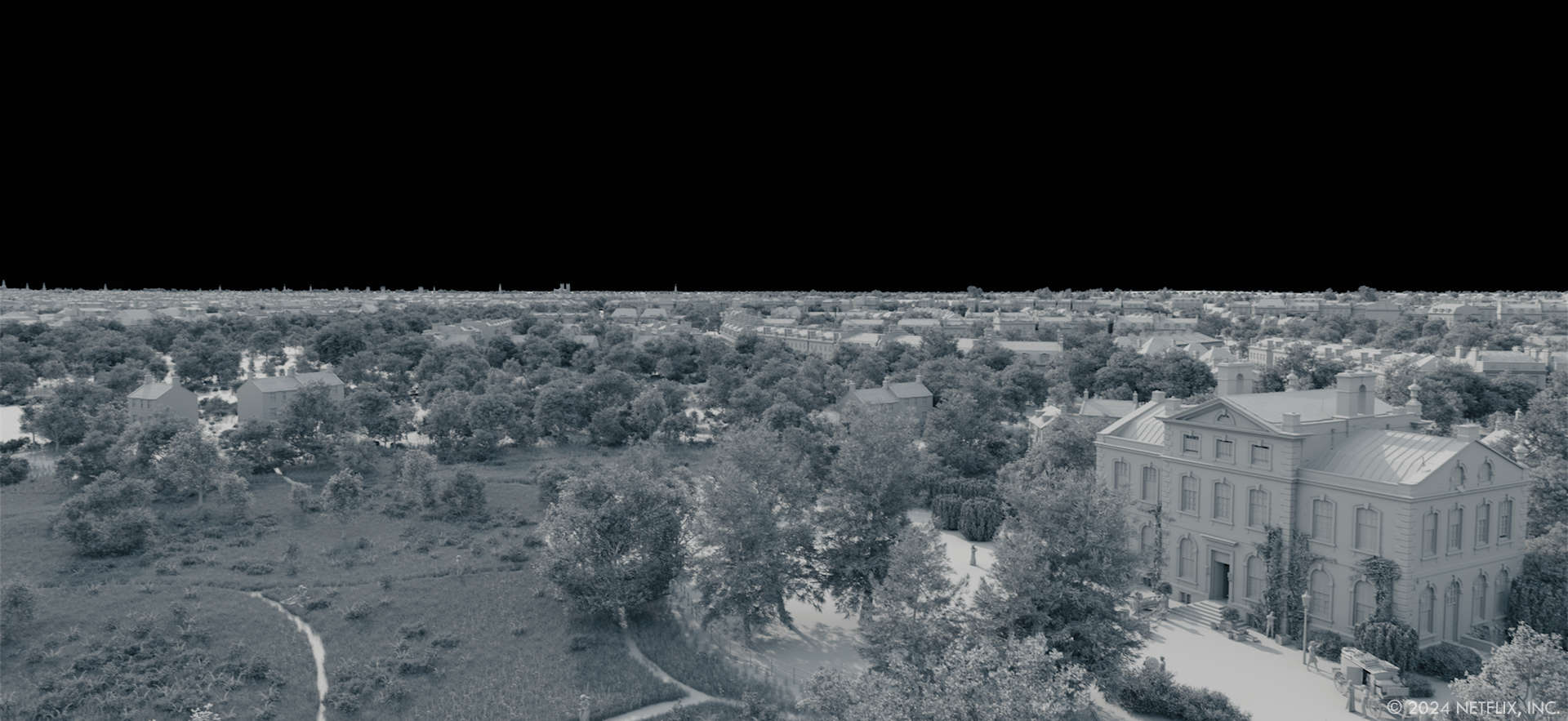
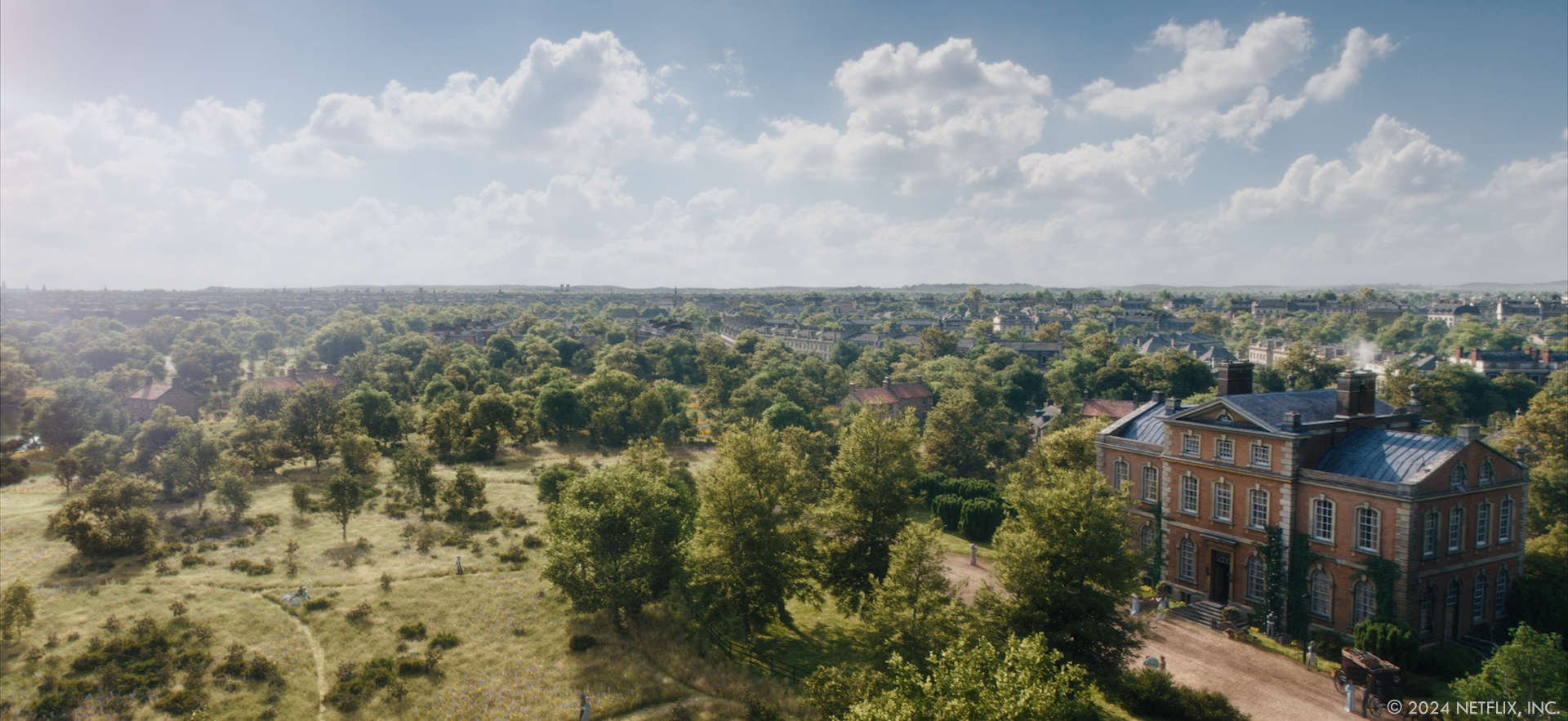
What specific technologies or software did you use to create the visual effects for the London environments?
For the full CG environments, layout and light/render were all Houdini, with assets built in Maya. The layout was pretty manual though; the distant background is more procedural and we had a setup for drawing a curve and then turning it into a row of houses, but the foreground stuff is all arranged by hand. For the extreme distance we would use DMP to be more efficient.
How did you handle the integration of live-action footage with CGI elements to maintain a seamless look?
Being involved from the pre-production stage meant we had access to locations and sets prior to shooting and so we could take advantage of this through LIDAR scanned environments, shooting texture refs and capturing HDRIs – all crucial in creating and integrating CG elements.
Were there any particular locations or landmarks in London that were especially difficult to recreate? If so, which ones and why?
There weren’t really any particular locations that were difficult to re-create, simply because of the huge amount of reference material that exists. The number of full CG environments that we created across the eight episodes easily ran into double figures. The challenge was trying to give each establisher its own identity and original look, even though the majority of them were London establishers.
How did you collaborate with the production design and costume departments to ensure cohesive and immersive visuals?
We collaborated from the pre-production stage so we were able to scan and photograph costumes to ensure our CG crowd had the correct clothing of the time. As we relied on CG crowd to populate our CG establishers and a number of environments, collaborating with production design and costume meant we could ensure the movement of our mo-cap actors was correct. There was a certain social etiquette of the time as well – ladies would need to be accompanied by men in certain locations and times of day; positions of hands, postures and walk cycles were all quite different to what they are today; so we needed to ensure this translated to our CG crowd.
Can you walk us through the process of creating the hot air balloon scene in the park?
This sequence would not have been possible had we not been involved at the pre-production stage. A lot of research and collaboration was done to establish an authentic look for the balloon and gondolier. Balloons around the Bridgerton time were commonly gas filled – helium or hydrogen – so we knew from the start there’d be no need for a gas-powered burner which you commonly see on balloons today.
Following on from this we had many discussions on the best way to propel the basket, finally deciding on having a large mobile tower crane on set for the duration of the shoot, meaning all movement was provided by the crane’s 65m extending arm and a bespoke steel rig which the ropes and main ring from the basket would be secured to. With safety of all crew and actors being paramount there were a number of days spent doing stunt rehearsals. This was also valuable in providing VFX with an initial view as to how the basket would move when being attached to the crane. We able to finesse this to also look like the basket movement was being motivated by a balloon rather than being swung by a crane.

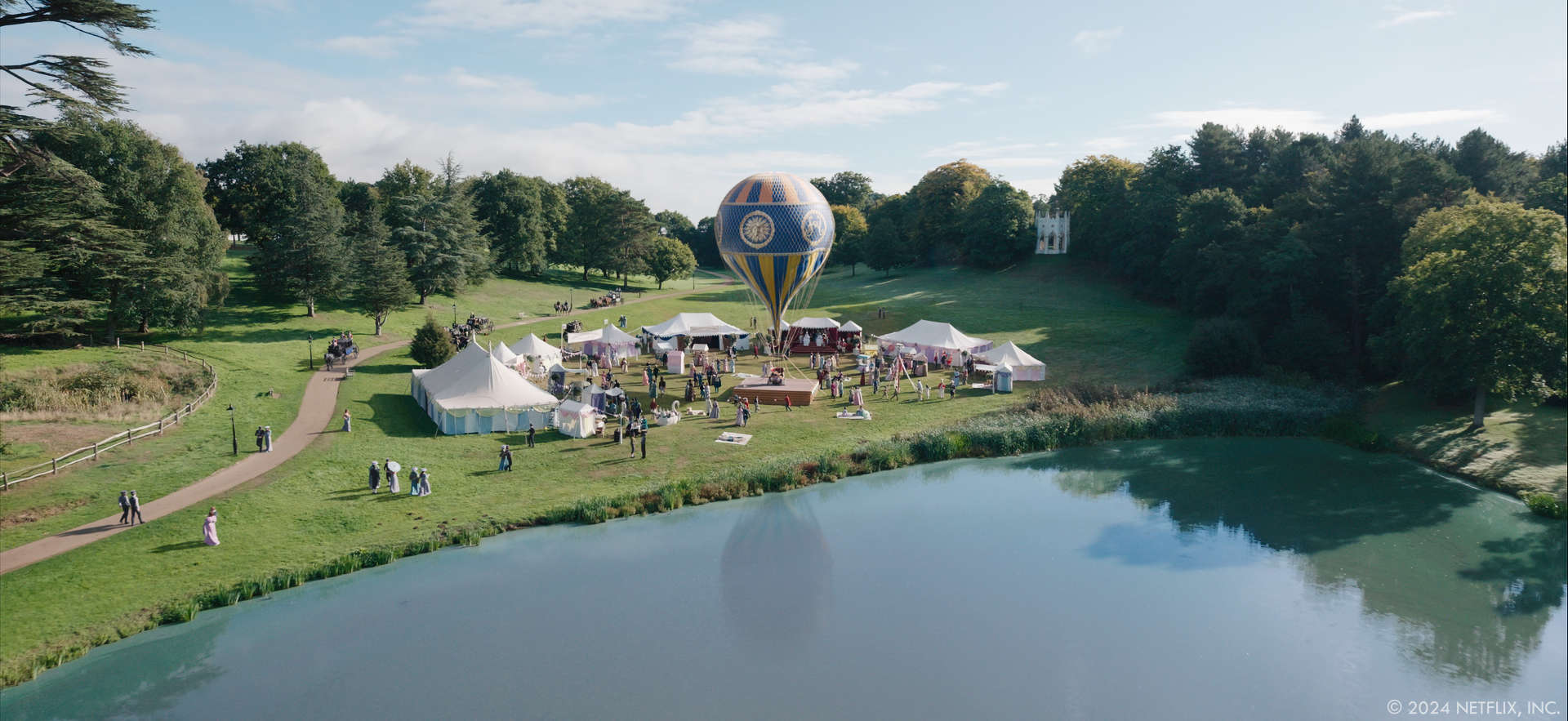
What were the biggest challenges in animating the hot air balloon?
Getting the correct movement on the balloon on the shooting days, we knew that shooting the balloon movement in profile wouldn’t look convincing once we added our CG balloon, mainly because of the much lower pivot point we had from using the crane to move the basket. We worked closely with the Director, Andrew Ahn, to always try and shoot the basket moving towards, away, or across camera – rather than in profile.
There were challenges presented by the shoot location, especially the need to not cause any damage to the environment and protect all of the terrain in Painshill Park. So once we’d established the rig and crane position, we were limited by how much it could be moved, and if it was being moved we had to use tracks and runways which resulted in a lot of VFX cleanup.
How did you ensure that the hot air balloon’s movements were accurate?
We did a lot of research into balloon movement, especially landing and takeoffs in windy conditions. Even before the shoot we started to create simulations in Houdini so we could then isolate the movement of the basket under varying strengths of wind. It meant that before shooting we had a really good idea of how the crane should move the basket, which we could then relay to the stunt team and Director.
Were there any particular references or inspirations you used for designing the hot air balloon?
Inspiration came from early prints and paintings. What was interesting was how popular ballooning was in the early 1800s. There were regular launches – some more successful than others – races and festivals across London. We also learnt that at this time the balloons would be filled with either hydrogen or helium, and generally filled from timber barrels away from the launch site. The ability to ascend and descend was limited, relying on wind and releasing the gas via ropes, pulleys, and large fabric tear strips – all of these are features we tried to incorporate into our balloon design.
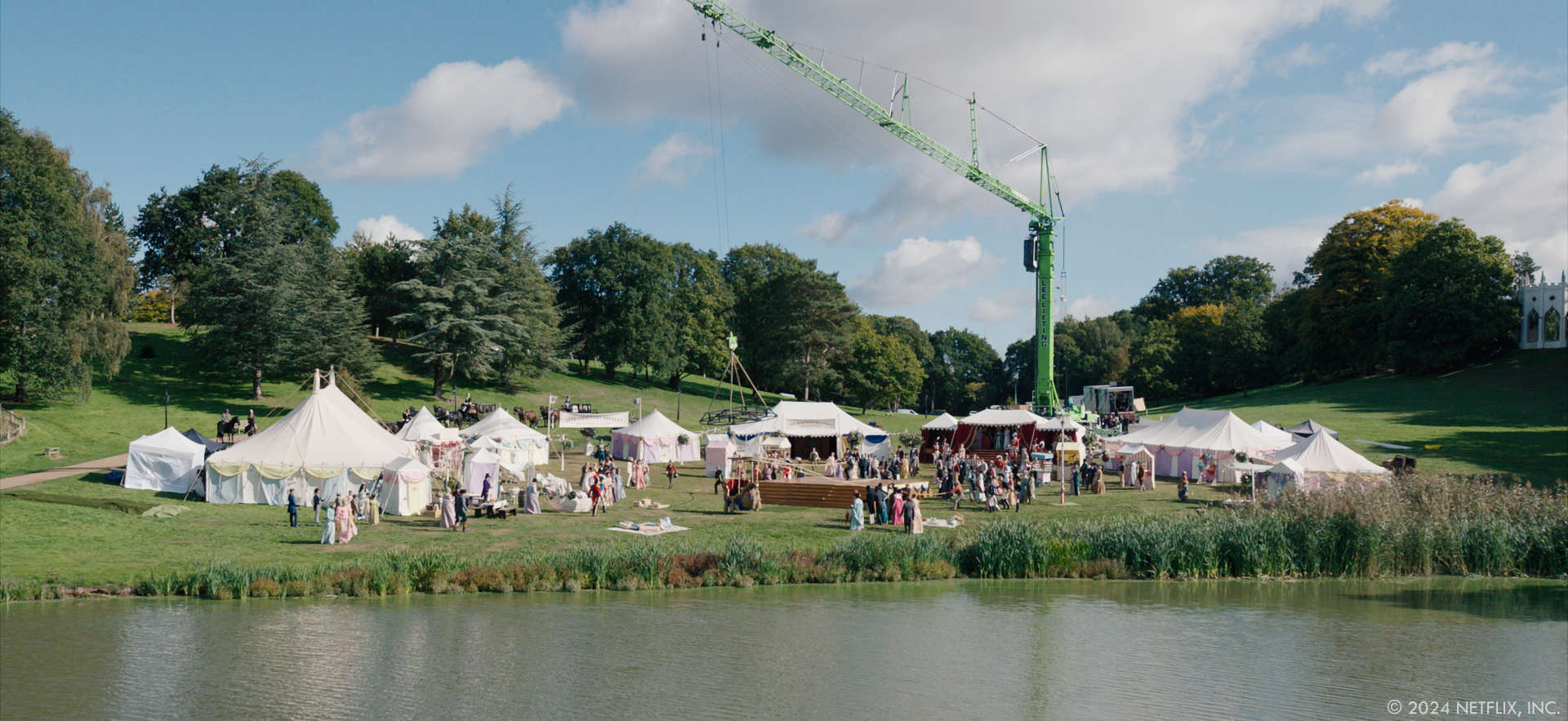
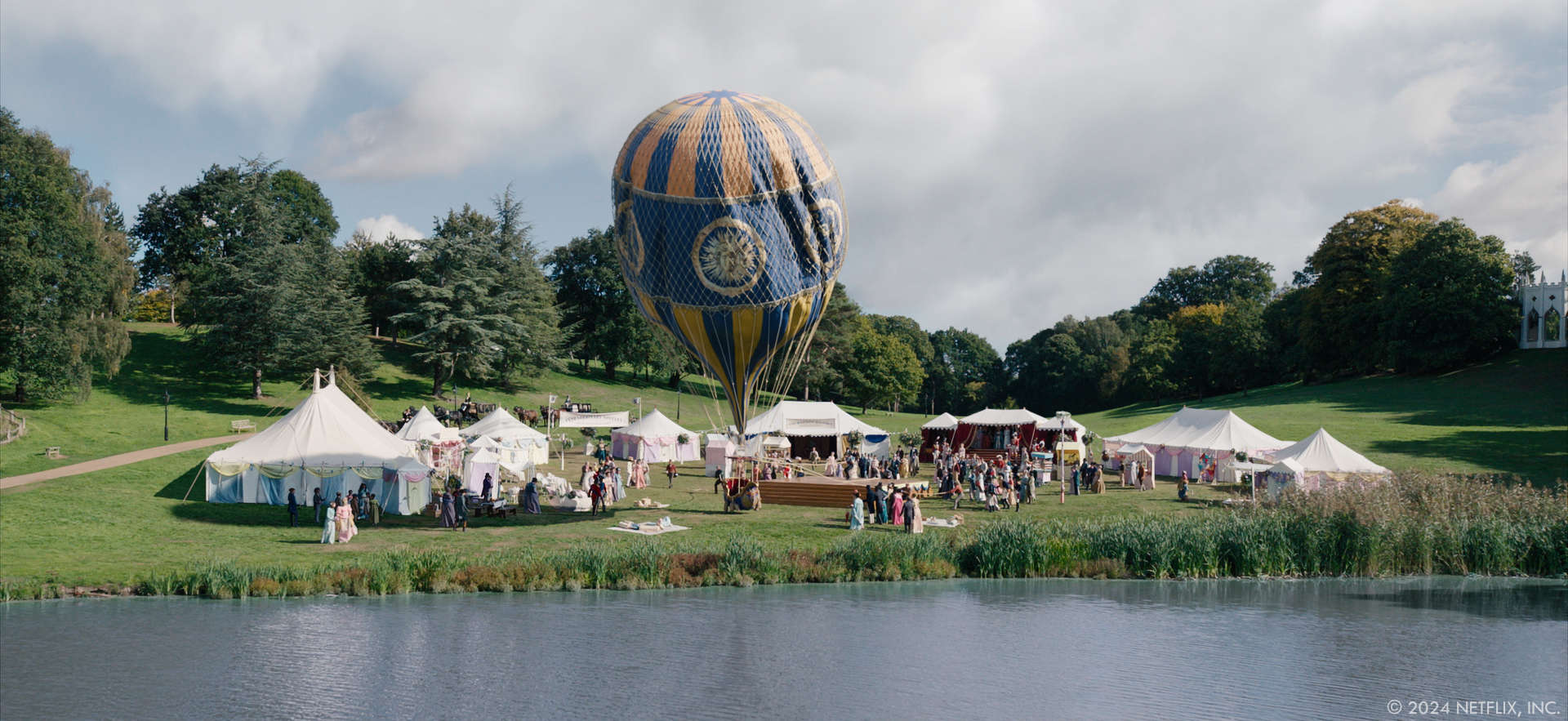
What was the inspiration behind the Butterfly Ball sequence, and how did you conceptualize the butterfly effects for this scene?
The main inspiration was the natural world. We did a lot of RnD work around replicating the real takeoff, landing, hovering and flight paths of Monarch butterflies. Prior to shooting this scene, we had already established the number of butterflies needed to create a spectacle in what was quite a large ballroom, meaning we could direct eyelines accurately on set. As with the balloon sequence in episode three, we got started on CG simulations early, deciding how the butterflies would exit the cages and fly to the ceiling prior to the shooting. We worked in a way that our previz was done on LIDAR scans meaning we were only tweaking our previz for final animation rather than restarting after shooting.
Can you explain the technical process of animating the butterflies to ensure they appeared natural and lifelike?
We didn’t simulate the butterflies and instead animated them with curves, but we had tools to make that more of a bulk process. We would draw a single curve then procedurally split it into multiple curves and add noise. Then the butterflies would move along the curves while looping one of several behaviours we had prepared, like flapping and gliding. This was faster and more art directable than simulation. We then did more manual work on the hero ones using the same tools.
Looking back on the project, what aspects of the visual effects are you most proud of?
I’m really proud of the balloon sequence. It was described to me as the first major stunt sequence in Bridgerton history and it was a pleasure to be part of the team on set that made it happen safely and in a way that gave the Outpost VFX team everything they needed to add the CG balloon and make it look real. It was a real team effort from pre-production right through to final delivery, as is always the case with Bridgerton.
Tricky question, what is your favorite shot or sequence?
Again, the balloon sequence. I just think creatively we got it right and made something that felt tangibly real for audiences. We’ve had many compliments on those shots from people that don’t work in VFX which is always nice as we know the VFX component enhanced the experience for them without them knowing it was CG.
How long have you worked on this show?
Roughly two years in total.
What’s the VFX shots count?
380 shots.
What is your next project?
I’m currently working on a feature film that is a bit of a departure from living in the 19th Century for the last two years! I have to keep what it is under wraps for now but it’s exciting.
What are the four movies that gave you the passion for cinema?
You’ve asked for four but I’m giving you six!
- Easy Rider
- True Romance
- Apocalypse Now (for the story behind the making of the film)
- The Goonies
- Stand By Me
- Raging Bull
A big thanks for your time.
WANT TO KNOW MORE?
Outpost VFX: Dedicated page about Bridgerton – Season 3 on Outpost VFX website.
© Vincent Frei – The Art of VFX – 2024






